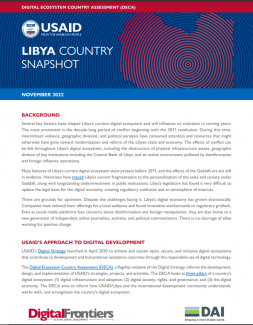Several key factors have shaped Libya’s current digital ecosystem and will influence its evolution in coming years. The most prominent is the decade-long period of conflict beginning with the 2011 revolution. During this time, intermittent violence, geographic divisions, and political paralysis have consumed attention and resources that might otherwise have gone toward modernization and reform of the Libyan state and economy. The effects of conflict can be felt throughout Libya’s digital ecosystem, including the destruction of physical infrastructure assets, geographic division of key institutions including the Central Bank of Libya, and an online environment polluted by disinformation and foreign influence operations.
Many features of Libya’s current digital ecosystem were present before 2011, and the effects of the Gaddafi era are still in evidence. Historians have traced Libya’s current fragmentation to the personalization of the state and society under Gaddafi, along with longstanding underinvestment in public institutions. Libya’s legislature has found it very difficult to update the legal basis for the digital economy, creating regulatory confusion and an atmosphere of mistrust.
There are grounds for optimism. Despite the challenges facing it, Libya’s digital economy has grown dramatically. Companies have tailored their offerings for a local audience and found innovative workarounds to regulatory gridlock. Even as social media platforms face concerns about disinformation and foreign manipulation, they are also home to a new generation of independent online journalists, activists, and political commentators. There is no shortage of allies working for positive change.

